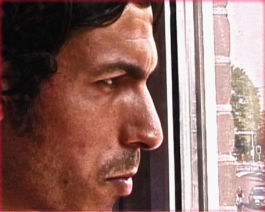




January 11 – 19, 2007
Exhibition, videoscreenings and discussion curated by Alexandra Blättler and Jen Liu
7 artists on the theme of alter ego: Alex Bag, Keren Cytter, Kate Gilmore, Shana Moulton, Laura Parnes, Elodie Pong, Isabell Spengler.
Discussion with Isabell Spengler and Philip Ursprung.
Akademie Schloss Solitude in cooperation with fluctuating images and in cooperation with 20. Filmwinter Stuttgart
I could be you – Akademie Schloss Solitude at fluctuating images
Opening: Thursday, January 11, 8pm
Sunday Tea & Screening: Sunday, January 14, 11:30am – 1:30pm. Videos by Laura Parnes (BLOOD & GUTS IN HIGH SCHOOL 1-4, 2004, 27’30’’) and Elodie Pong (SECRETS, 2003, chaine of videos).
Discussion & Closing Reception with Isabell Spengler and Philip Ursprung: Friday, January 19, 8pm
ALTER EGO ROLE PLAY
All participants in the role play have another person standing behind them with their hands on their shoulders, acting as alter egos. The alter ego says out loud, during the role play, what he or she thinks the person is really thinking or feeling, e.g.:
Participant: "Oh hello! How very nice to see you!"
Alter ego: "Oh no, not him again!"
In the early 20th century, the term of “alter ego” was used to describe the so called wrong identities of schizophrenic patients. Since then the definition developed into a personal attribute, demonstrated as a second Ego to the outside world.
In literature different writers and poets, most notably since the beginning of the 20th century, such as Samuel Beckett, James Joyce and Marcel Proust, deal with the existence of a second Ego. However, since video and film began to be integrated into the fine arts, narrative structures and their related literary concepts of the “alter ego” subject were also assimilated by artists. In the wake of 1990s identity politics, and following the postmodernist dialectic concerning the constructed self (Donna Haraway’s Cyborg), many artists working today question the possible meanings of “identity”. The artists in »I Could Be You« use their own bodies, and those of others, to express individual and particular cultural positions as an “alter ego”, whereas they allegorise constructed characters and dialectical objects.
Video programme:
THE ARTIST’S MIND, 1996, Alex Bag (USA)
DREAMTALK, 2005, Keren Cytter (IL)
DOWN, SMILING, 2006, Kate Gilmore (USA)
WHISPERING PINES NO. 5, 2005, Shana Moulton (USA)
BLOOD & GUTS IN HIGH SCHOOL 1-4, 2004, Laura Parnes (USA)
JE SUIS UNE BOMBE, 2006, Elodie Pong (CH)
SECRETS, 2003, Elodie Pong (CH)
PERMANENT RESIDENTS, 2005, Isabell Spengler (DE)
Further information about the videos: download pdf
The show is curated by Alexandra Blättler (curator, Zurich) and Jen Liu (artist, New York, Solitude-grant 2006).
More Information: www.akademie-solitude.de and www.wand5.de/fiwi2007/
German press text:
Vernissage: Donnerstag, 11. Januar 2007
Tea & Screening: Sonntag, 14. Januar 2007. Mit Videos von Laura Parnes (BLOOD & GUTS IN HIGH SCHOOL 1-4, 2004, 27’30’’) und Elodie Pong (SECRETS, 2003, Dauer: variabel).
Diskussion & Finissage mit den beiden Kuratorinnen sowie Isabell Spengler (Künstlerin) und Philip Ursprung (Professor für moderne und zeitgenössische Kunst an der Universität Zürich): Freitag, 19. Januar 2007
ALTER EGO ROLE PLAY
All participants in the role play have another person standing behind them with their hands on their shoulders, acting as alter egos. The alter ego says out loud, during the role play, what he or she thinks the person is really thinking or feeling, e.g.:
Participant: "Oh hello! How very nice to see you!"
Alter ego: "Oh no, not him again!"
Im frühen 20. Jahrhundert wurde der Begriff „Alter Ego“ für die so genannten falschen Identitäten schizophrener Patienten verwendet. Seitdem hat sich die Definition erweitert zu einer persönlichen Eigenschaft, die als zweites Ich nach Aussen getragen wird.
In der Literatur haben sich zahlreiche grosse Schriftsteller des 20. Jahrhunderts, wie z.B. Samuel Beckett, James Joyce und Marcel Proust, mit der Existenz eines zweiten Ichs beschäftigt. Seit Video und Film in die Bildende Kunst Eingang gefunden haben, beschäftigten sich auch Künstlerinnen und Künstler mit vergleichbaren narrativen Strukturen und literarischen Konzepten zur „Alter Ego“-Thematik.
Die Identitätspolitik der 1990er Jahre wie auch die postmoderne Dialektik des konstruierten Ichs (Donna Haraways Cyborg), haben Kunstschaffende dazu veranlasst, mögliche Bedeutungen der Identität in Frage zu stellen. Die Künstlerinnen bei »I Could Be You« benutzen ihren eigenen Körper und denjenigen anderer, um als „Alter Ego“ individuelle und allgemeine kulturelle Identitäten darzustellen, wobei es sich um konstruierte Charaktere und dialektische Objekte handelt.